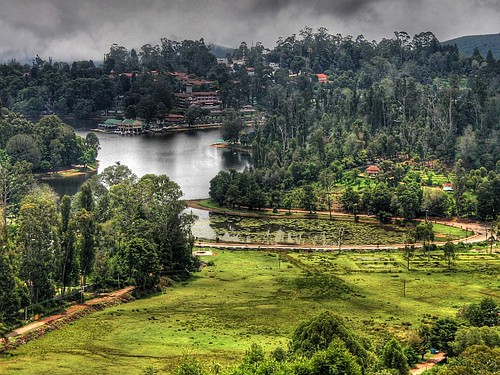Kodaikanal Hill Station
Kodaikanal - A Jewel of India
Called the ‘Princess of Hill Stations,’ Kodaikanal offers welcome relief from the heat and humidity of India in a serene, beautiful setting. The British sought the escape the heat as well as tropical diseases of India by building hill stations where they could vacation at. The two most popular hill stations in Tamil Nadu are Ooty and Kodaikanal. Set in a basin in the beautiful Palani hills at an altitude of 2,195 m (7,202 ft) and about a three hour bus ride from Madurai, the Kodaikanal hill station is a magnificent location offering spectacular views and stunning natural beauty.The Beauty of Kodaikanal
Compared to the congestion and bustle of the cities in India, Kodaikanal is a dreamy escape to dramatic scenery and serene treks through the countryside. The beautiful misty atmosphere and cool climate is a welcome change from the heat and humidity of the rest of India. The stunning vistas and distant peaks visible from various locations around Kodaikanal provide a peculiar sense of the splendor of India’s natural beauty. Nested in the Palani hills of western Tamil Nadu, Kodaikanal is also a fine repository of wildlife and plants endemic to the region. Kodaikanal is near the center of the proposed Palani Hills National Park, an effort to help preserve the region in its natural setting.The beauty of Kodaikanal can be experienced in a variety of manners. Hiking is perhaps the best way to explore the forests of Kodaikanal, and the well-trodden paths offer spectacular views and close encounters with wildlife and plants as well as caves and waterfalls. Biking and horse-riding are also available but with limited access to the more isolated spots.
The picturesque lake set in the center of Kodaikanal has been the subject of many a budding photographer and tourists relaxing on boats in the lake is a common sight. Furthermore, coffee plantations and peach and plum orchards dot the area. Various species of orchids and other beautiful flowers add color and vibrancy to the area.
History of the Indian Hill Station at Kodaikanal
An offshoot of the Western Ghats, the Palani hills near the Kerala border with Tamil Nadu were surveyed by Europeans in the early 1800’s and their reports of beautiful landscapes, wonderful climate as well as relative accessibility attracted American missionaries working out of Madurai to Kodaikanal. The first bungalows were built by 1845 and Kodaikanal soon became a popular holiday destination for the British administrators of India.The stunning landscape and clear, cool streams of Kodaikanal attracted locals too, especially after India’s independence from the British in 1947. Accommodations were built, but conscious effort has been made to preserve the natural beauty of the region and prevent the kind of unbridled urban development that has occurred at other hill stations in India.
Flora and Fauna of Kodaikanal
Kodaikanal has a temperature subtropical climate due to its high altitude, and temperatures are quite cool by Indian standards, and freezing temperatures sometimes occur in the winter. The summer months from March to May when the weather is mild and dry are the best time to experience Kodaikanal in all its glorious beauty.The Palani hills region around Kodaikanal lies in a unique ecosystem comprising of high-altitude stunted evergreen forests knows as shola that are found in patches, with the patches separated from each other by undulating grasslands. The high altitude and constant wind prevents the trees here from reaching the heights of other forests. The moss and lichen laden forests here are, however, prime watersheds and help regulate the ecosystem of the region.
A globally recognized biodiversity hotspot, the forests around Kodaikanal is home to numerous species of mammals and trees, including panthers, tigers and elephants. The Palni hills surrounding Kodaikanal also feature steep rock escarpments. The rock bluffs and precipices, sometimes overlooking sheer drops of thousands of feet, are home to the endemic Nilgiri langur and Nilgiri tahr, an endangered “goat-sheep” native to the Indian subcontinent, as well as the Indian rock python.
Kodaikanal is as beautiful as it is serene. Set in a land of timeless beauty, its splendor and magnificence is perhaps matched only by a handful of locations around the world.





Comment Form under post in blogger/blogspot